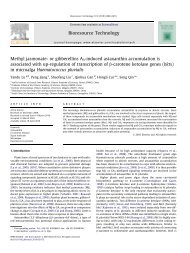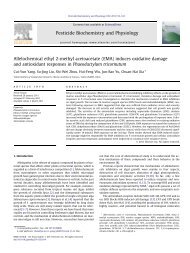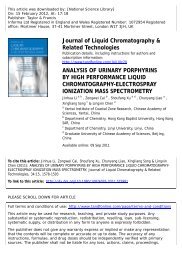Physicochemical properties of gelatin gels from walleye ... - YIC-IR
Physicochemical properties of gelatin gels from walleye ... - YIC-IR
Physicochemical properties of gelatin gels from walleye ... - YIC-IR
You also want an ePaper? Increase the reach of your titles
YUMPU automatically turns print PDFs into web optimized ePapers that Google loves.
910<br />
s<strong>of</strong>tware (Thermo-Nicolet, Madison, Wisconsin). The spectra<br />
obtained were used to determine possible interactions <strong>of</strong> functional<br />
groups in <strong>gelatin</strong> molecules and gallic acid or rutin.<br />
2.11. Statistical analysis<br />
Statistical data were analyzed using Micros<strong>of</strong>t Excel 2000 and<br />
Origin 7.5. Student’s t-test was applied to compare the averages <strong>of</strong><br />
<strong>properties</strong> with a level <strong>of</strong> 95% confidence interval.<br />
3. Results and discussion<br />
3.1. Gel strength<br />
Gel strength is one <strong>of</strong> the important <strong>properties</strong> <strong>of</strong> <strong>gels</strong>, and the<br />
specific application <strong>of</strong> a gel is determined by the range <strong>of</strong> gel<br />
strength values (Cho, Gu, & Kim, 2005). As shown in Fig. 1, we<br />
plotted gel strength <strong>of</strong> the cross-linked hydro<strong>gels</strong> as a function <strong>of</strong><br />
cross-linker concentration. The results showed that gel strength <strong>of</strong><br />
hydro<strong>gels</strong> cross-linked by gallic acid increased and then decreased<br />
as gallic acid concentration increased <strong>from</strong> 0 to 40 mg/g dry <strong>gelatin</strong>,<br />
and the highest value was found to be at 20 mg/g dry <strong>gelatin</strong> <strong>of</strong><br />
gallic acid. The introduction <strong>of</strong> gallic acid at a level <strong>of</strong> 20 mg/g dry<br />
<strong>gelatin</strong> resulted in increase in the gel strength by 32.5% (p < 0.05)<br />
compared with that <strong>of</strong> untreated hydrogel. As for hydro<strong>gels</strong> treated<br />
with rutin, gel strength continuously increased as rutin concentration<br />
increased <strong>from</strong> 0 to 8 mg/g dry <strong>gelatin</strong>, and the maximum<br />
value appeared at 8 mg/g dry <strong>gelatin</strong>, which was also the highest<br />
one in all studied hydro<strong>gels</strong>. With the addition <strong>of</strong> 8 mg/g dry <strong>gelatin</strong><br />
<strong>of</strong> rutin, the gel strength increased by 76.3% (p < 0.01) compared<br />
with that <strong>of</strong> untreated hydrogel. However, when rutin was further<br />
increased to 9 mg/g dry <strong>gelatin</strong>, there was granule precipitate in<br />
hydro<strong>gels</strong>, which could also be found in previous studies (Naczk,<br />
Grant, Zadernowski, & Barre, 2006). Silber, Davitt, Khairutdinov,<br />
and Hurst (1998) postulated that protein could be precipitated by<br />
polyphenols when the number <strong>of</strong> polyphenol molecules interacting<br />
with a protein molecule reached a critical value. The gel strength <strong>of</strong><br />
modified hydrogel decreased evidently after inclusion <strong>of</strong> 30 mg/g<br />
dry <strong>gelatin</strong> <strong>of</strong> gallic acid, the reason <strong>of</strong> which might be the formation<br />
<strong>of</strong> a sufficient coating <strong>of</strong> protein surfaces by polyphenol<br />
molecules (Charlton et al., 2002). The further decrease in strength<br />
<strong>of</strong> modified hydro<strong>gels</strong> cross-linked with gallic acid at 40 mg/g dry<br />
<strong>gelatin</strong>, and the appearance <strong>of</strong> granule precipitate in hydrogel<br />
modified with 9 mg/g dry <strong>gelatin</strong> <strong>of</strong> rutin, may be due to the<br />
polyphenol binding to the protein surface and cross-linking <strong>of</strong><br />
different protein molecules with polyphenols (Charlton et al., 2002;<br />
Papadopoulou & Frazier, 2004). It could be found that as a crosslinking<br />
agent, the concentration <strong>of</strong> rutin needed in the cross-linked<br />
hydrogel was much lower than that <strong>of</strong> gallic acid, which might<br />
mainly be related to the molecular weight and molecular structure<br />
<strong>of</strong> rutin and gallic acid.<br />
3.2. Viscoelastic <strong>properties</strong><br />
Viscoelastic <strong>properties</strong> refer to the changes <strong>of</strong> viscoelastic<br />
modulus in solehydrogel conversion. The viscoelastic <strong>properties</strong> <strong>of</strong><br />
hydro<strong>gels</strong>, after the addition <strong>of</strong> cross-linking agent, are shown in<br />
Fig. 2. The modulus <strong>of</strong> elasticity (G 0 ), modulus <strong>of</strong> viscosity (G 00 ) and<br />
the phase angle (d) all displayed sigmoidal curves during both<br />
heating (<strong>from</strong> 0 to 50 C) and subsequent cooling (<strong>from</strong> 50 to 0 C)<br />
ramp, similar to other reports (Cho et al., 2005; Fernández-Díaz,<br />
Montero, & Gómez-Guillén, 2001; Gómez-Guillén et al., 2002).<br />
Either ingredient could improve the G 0 and G 00 <strong>of</strong> hydrogel, the most<br />
effective being rutin at 8 mg/g dry <strong>gelatin</strong>. In general, the increase<br />
<strong>of</strong> G 0 is due to the increasing number <strong>of</strong> chemical junctions<br />
M. Yan et al. / Food Hydrocolloids 25 (2011) 907e914<br />
responsible for the formation <strong>of</strong> the amide bonds (Saito et al.,<br />
2007). That is to say, the hydro<strong>gels</strong> modified with gallic acid and<br />
rutin had greater cross-linking density than the untreated hydrogel,<br />
which could be observed in the following studies. However, as<br />
deduced <strong>from</strong> the evolution <strong>of</strong> the phase angle, gallic acid and rutin<br />
had no significant effect on the hydrogelesol transition temperature.<br />
The hydro<strong>gels</strong>, whether the cross-linking agent was introduced<br />
or not, showed the gelling temperature at 4e6 C and the<br />
melting temperature at 11e13 C. The reason is not clear, however,<br />
it may be hypothesized that this might be related to the forces <strong>of</strong><br />
interaction between polypeptide chains <strong>of</strong> <strong>gelatin</strong>.<br />
3.3. Thermal stability<br />
It is important to carry out studies on the thermal <strong>properties</strong> and<br />
stability <strong>of</strong> <strong>gels</strong> containing gallic acid and rutin for their application<br />
in food and pharmaceutical industry as the <strong>gels</strong> may be subjected to<br />
heat processes during their preparation, processing or consumption<br />
(Mathew & Abraham, 2008). Changes in thermal stability are<br />
good indicator <strong>of</strong> proteinephenol interactions. Shrinkage temperature<br />
Ts is usually used to describe the thermal stability <strong>of</strong> <strong>gels</strong>, and<br />
is defined as the temperature corresponding to the rupture <strong>of</strong> the<br />
inter-chain bonds resulting in the fusion <strong>of</strong> the oriented peptide<br />
chains (Flory & Garrett, 1958). Differential scanning calorimetry<br />
thermograms <strong>of</strong> gallic acid and rutin incorporated xero<strong>gels</strong> are<br />
shown in Fig. 3. The xero<strong>gels</strong> with and without cross-linking agents<br />
all exhibited a single peak, and the peak value corresponded to the<br />
shrinkage temperature. So the Ts was 89 C for untreated xerogel,<br />
90 C for gallic acid-modified xerogel and 100 C for rutin-modified<br />
xerogel. The Ts <strong>of</strong> xero<strong>gels</strong> treated with 6 and 8 mg/g dry <strong>gelatin</strong> <strong>of</strong><br />
rutin were both 11 C higher than that <strong>of</strong> the untreated xerogel<br />
implying that rutin was able to further impart thermal stability to<br />
xerogel, but Ts <strong>of</strong> xero<strong>gels</strong> modified with 20 and 30 mg/g dry <strong>gelatin</strong><br />
<strong>of</strong> gallic acid showed no distinct variation compared with that <strong>of</strong><br />
untreated xerogel. A rise in Ts reflects an increase in the average<br />
number <strong>of</strong> cross-linking junctions per molecule, which suggests<br />
that xero<strong>gels</strong> treated with rutin had better cross-linking network<br />
than gallic acid-modified xero<strong>gels</strong> and the untreated xerogel.<br />
Fig. 3. Thermal transition curve <strong>of</strong> xero<strong>gels</strong> <strong>from</strong> <strong>walleye</strong> pollock skin with and<br />
without cross-linking agents (gallic acid or rutin), as shown by DSC.








